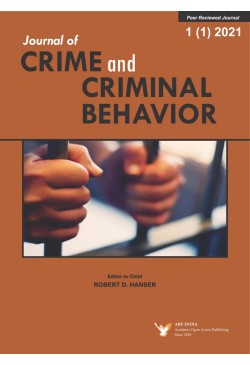
Journal of Crime and Criminal Behavior
Frequency :Bi-Annual
ISSN :2583-0244
Peer Reviewed Journal
The Role of Mental Health in Addressing Institutional Misconduct of Offenders with Personality Disorders
Personality disorders, particularly cluster B, pose significant challenges to the successful management of inmates in correctional institutions. Maladaptive personality traits coupled with negative prison environments tend to magnify the dysfunctional behavior of incarcerated individuals and increase the potential for institutional misconduct. The aims of this article is to address some of the barriers to the management of inmates with personality disorders and discuss possible solutions for mental health professionals and prison administrators alike.
Keywords: personality disorders, institutional misconduct, mental health, Cluster B, segregation
Prison Constructions Comparing Sexual Adaptations of Men and Women while Incarcerated
Men and women face several options when they enter prison, including the normative and behavioral expression of sexuality. Four general explanations have developed which empirically test these options. These include four perspectives: prison subculture, deprivation, importation, and the most recent gender fluidity. Most research has been concerned with the sexuality of inmates entering prison and their adaptations while incarcerated. Refining and extending this principal theme, the present project uses interviews conducted by the first author over a thirty-one-year period to specify adaptations by individuals to daily institutional life. Most of these interviews concern sex while others focus on violence. Previous research has mainly focused on men or women while this research involves comparisons between men and women. Inmate adaptations are put into one of the above four explanations using a best fit method. Gender theory and the concept of total institutions will also be discussed. Our purpose is to use the best fit method to determine what explanations are most equipped to understand sexual adaptation among prisoners/inmates. All explanations are supported by the data; finding these adaptations to exist both with men and women inmates. Prison subculture appears to be the primary adaptation for men, while gender fluidity is primary among women.
Keywords: adaptations to prison; gender fluidity; prison subculture; deprivation; importation; sexuality; total institutions; gender theory.
Female-Perpetrated Multiple-Victim Homicides in Ghana
Research specifically investigating female-perpetrated multiple-victim homicide has been sparse with the result that there is limited understanding of the behavior. The goal of the present study therefore was to explore the extent and nature of female-perpetrated multiple-victim homicides that occurred in Ghana during 2010-2020 in order to better understand the phenomenon. The study employed media surveillance methodology. Information was extracted from various print and electronic media sources in Ghana. The results show that female-perpetrated multiple-victim homicide is a rare crime in the society. The study identified 6 cases over a 31-year period. Each crime was highly publicized by the mass media and was the subject of intense public interest and discussion. Each elicited widespread public condemnation, with citizens describing the crimes as actions of depraved, and antisocial malefactors, or at best, mentally disordered persons. Most of the female-perpetrated multiple-victim homicide events were maternal filicide incidents in which mothers killed their own children. Psychopathology appeared to be a factor in 3 of the 6 filicides. Suicide occurred in 2 of the 6 homicide events. Many of the crimes continue to be topical issues in Ghana today, even several years after their occurrence. Case narratives for all six cases are provided. Additional research from non-western, non-industrial societies is needed to broaden understanding of and linkages between gender and multiple-victim homicide.